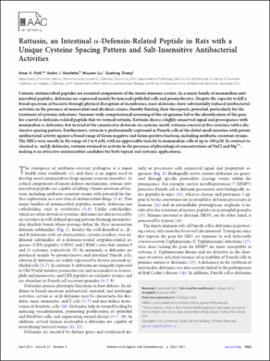| dc.contributor.author | Patil, Amar A. | |
| dc.contributor.author | Ouellette, Andre J. | |
| dc.contributor.author | Lu, Wuyuan | |
| dc.contributor.author | Zhang, Guolong | |
| dc.date.accessioned | 2018-08-17T16:24:55Z | |
| dc.date.available | 2018-08-17T16:24:55Z | |
| dc.date.issued | 2013-04 | |
| dc.identifier | oksd_patil_rattusinaninte_2013 | |
| dc.identifier.citation | Patil, A. A., Ouellette, A. J., Lu, W., & Zhang, G. (2013). Rattusin, an intestinal a-defensin-related peptide in rats with a unique cysteine spacing pattern and salt-insensitive antibacterial activities. Antimicrobial Agents and Chemotherapy, 57(4), 1823-1831. https://doi.org/10.1128/AAC.02237-12 | |
| dc.identifier.uri | https://hdl.handle.net/11244/301446 | |
| dc.description.abstract | Cationic antimicrobial peptides are essential components of the innate immune system. As a major family of mammalian antimicrobial peptides, defensins are expressed mainly by mucosal epithelial cells and promyelocytes. Despite the capacity to kill a broad spectrum of bacteria through physical disruption of membranes, most defensins show substantially reduced antibacterial activities in the presence of monovalent and divalent cations, thereby limiting their therapeutic potential, particularly for the treatment of systemic infections. Genome-wide computational screening of the rat genome led to the identification of the gene for a novel a-defensin-related peptide that we termed rattusin. Rattusin shares a highly conserved signal and prosequence with mammalian a-defensins, but instead of the canonical a-defensin six-cysteine motif, rattusin consists of five cysteines with a distinctive spacing pattern. Furthermore, rattusin is preferentially expressed in Paneth cells of the distal small intestine with potent antibacterial activity against a broad range of Gram-negative and Gram-positive bacteria, including antibiotic-resistant strains. The MICs were mostly in the range of 2 to 4 uM, with no appreciable toxicity to mammalian cells at up to 100 uM. In contrast to classical a- and B-defensins, rattusin retained its activity in the presence of physiological concentrations of NaCl and Mg2+, making it an attractive antimicrobial candidate for both topical and systemic applications. | |
| dc.format | application/pdf | |
| dc.language | en_US | |
| dc.publisher | American Society for Microbiology | |
| dc.rights | This material has been previously published. In the Oklahoma State University Library's institutional repository this version is made available through the open access principles and the terms of agreement/consent between the author(s) and the publisher. The permission policy on the use, reproduction or distribution of the material falls under fair use for educational, scholarship, and research purposes. Contact Digital Resources and Discovery Services at lib-dls@okstate.edu or 405-744-9161 for further information. | |
| dc.title | Rattusin, an intestinal a-defensin-related peptide in rats with a unique cysteine spacing pattern and salt-insensitive antibacterial activities | |
| osu.filename | oksd_patil_rattusinaninte_2013.pdf | |
| dc.description.peerreview | Peer reviewed | |
| dc.identifier.doi | 10.1128/AAC.02237-12 | |
| dc.description.department | Animal Science | |
| dc.type.genre | Article | |
| dc.type.material | Text | |
| dc.subject.keywords | antibacterial agent | |
| dc.subject.keywords | salt | |
| dc.subject.keywords | cysteine | |
| dc.subject.keywords | peptides | |
| dc.subject.keywords | a-defensin | |
| dc.subject.keywords | sulfur containing aminoacid | |
| dc.subject.keywords | digestive system | |
| dc.subject.keywords | vertebrata | |
| dc.subject.keywords | mammalia | |
| dc.subject.keywords | rodentia | |
